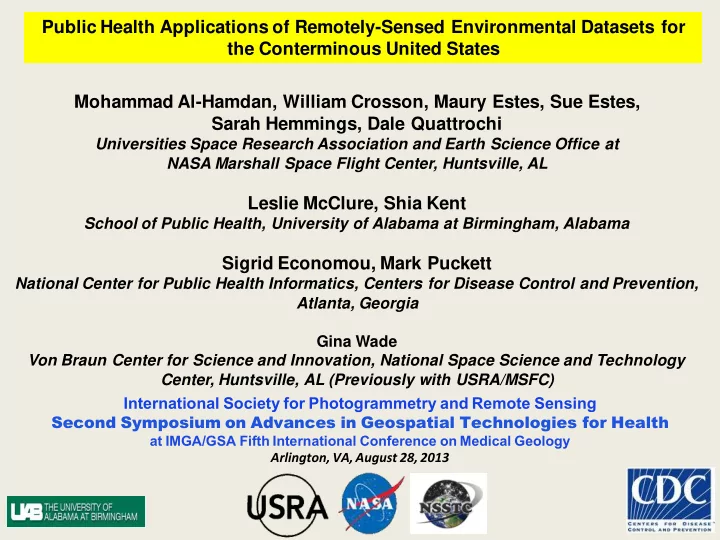

Public Health Applications of Remotely-Sensed Environmental Datasets for the Conterminous United States Mohammad Al-Hamdan, William Crosson, Maury Estes, Sue Estes, Sarah Hemmings, Dale Quattrochi Universities Space Research Association and Earth Science Office at NASA Marshall Space Flight Center, Huntsville, AL Leslie McClure, Shia Kent School of Public Health, University of Alabama at Birmingham, Alabama Sigrid Economou, Mark Puckett National Center for Public Health Informatics, Centers for Disease Control and Prevention, Atlanta, Georgia Gina Wade Von Braun Center for Science and Innovation, National Space Science and Technology Center, Huntsville, AL (Previously with USRA/MSFC) International Society for Photogrammetry and Remote Sensing Second Symposium on Advances in Geospatial Technologies for Health at IMGA/GSA Fifth International Conference on Medical Geology Arlington, VA, August 28, 2013
Goals and Objectives This project has dual goals in decision-making activities Providing information to decision makers about associations between environmental exposures and health conditions in a large national cohort study Enriching the CDC Wide-ranging Online Data for Epidemiologic Research (WONDER) system by integrating environmental exposure data Develop daily high-quality spatial data sets of environmental variables for the conterminous U.S. for the years 2003-2008 utilizing NASA data (Objective 1) Fine Particulates (PM 2.5 ) (NASA MODIS and EPA AQS) Land Surface Temperature (NASA MODIS) Solar Insolation and Heat-related Products (Reanalysis Data) Link these environmental variables with public health data from a national cohort study and examine environmental health relationships (Objective 2) Cognitive Function Hypertension Make the environmental datasets available to public health professionals, researchers and the general public via the CDC WONDER system (Objective 3)
Environmental Health Implications Fine Particulates (PM2.5) Human observation studies show that exposure to general pollution containing PM2.5 could cause inflammation, degradation, and oxidation in the brain when inhaled and could lead to altered regulation of biomarkers involved in cognitive function Possible risk factor for cardiovascular and respiratory diseases Solar Insolation Some research suggests that a relationship between sunlight exposure and cognition exists by affecting brain blood flow Heat Exposure Some research suggests that a relationship between heat exposure and hypertension exists by affecting stress level
National Environmental Datasets (Objective 1)
Fine Particulate Matter (PM 2.5 ) Estimated ground-level PM 2.5 from MODIS AOD using published regression equations per EPA region per season (Zhang et al., 2009) Combined with EPA PM 2.5 data from the AQS for 2003-2008 Modified and ran MSFC Surfacing Algorithm (Al-Hamdan et al., 2009, 2012) to produce continuous spatial surfaces of daily PM 2.5 for the contiguous US for 2003-2008 PM 2.5 on July 14, 2003 (10 km spatial resolution)
Land Surface Temperature (LST) Aqua and Terra daytime & nighttime data for 2003-2008 were processed Aqua-Terra differences were computed by season for 2003-2008 Aqua data gaps were filled with Terra-adjusted LST (if available) by mean seasonal difference National merged Aqua-Terra daily LST dataset were generated for 2003-2008 for day & night (Crosson et al., 2012) (1 km spatial resolution)
Heat and Solar Insolation NLDAS hourly forcing data (air temperature, solar radiation, specific humidity, atmospheric pressure) for the 2003-2008 period were processed Daily statistics of Maximum Air Temperature, Minimum Air Temperature, Maximum Heat Index, and Total Solar Insolation were computed for 2003-2008 (12 km spatial resolution)
Environmental Health Data Linkage (Objective 2)
REasons for Geographic And Racial Differences in Stroke (REGARDS) Study Population Longitudinal population-based cohort of over 30,000 volunteers age 45 and older Racial representation • 42% African American • 58% white Sex representation • 45% male White • 55% female African American Geographic representation • 21% from the buckle of the stroke belt • 35% from the stroke belt • 44% from the rest of the contiguous US Successfully transferred from UAB to NASA/MSFC • BAA as per HIPPA Regulations • Data Encryption
Data Linkage for Biostatistical Analyses Link in a GIS the estimates of the PM 2.5 , Solar Insolation, and Air Temperature with health data from all participants in the REGARDS study on the individual level at the geographic coordinates of their residences Sort the environmental data by participant ID, and merge in with the corresponding health data from the REGARDS database Determine whether exposures to these environmental risk factors are related to cognitive decline and other health outcomes such as hypertension, inflammation, and stroke Simulated example of the linked data set consisting of participant ID and the associated NLDAS solar insolation
Data Dissemination via CDC WONDER (Objective 3)
Data Dissemination via CDC WONDER Environmental exposure datasets will be made available to public health professionals, researchers and the general public via WONDER, where they can be aggregated to the county- level or higher as per users’ need Users are able to spatially and temporally query datasets and create county- and higher-level maps and downloadable statistical tables and charts of data across the contiguous U.S. Enabling easy linkage of the environmental exposure data with other health data available via CDC WONDER
CDC WONDER Main Web Page http://wonder.cdc.gov/
NLDAS-derived Heat-related Products on CDC WONDER Now Available at http://wonder.cdc.gov/nasa-nldas.html
CDC WONDER Tabular Results
CDC WONDER Map Results
CDC WONDER Chart Results
CDC WONDER Spatial/Temporal Aggregation July 15-17, 2007 Jan 1-Dec 31, 2007 July 15-17, 2007 Jan 1-Dec 31, 2007
Summary Development of national daily products of PM 2.5 (2003-2011), LST (2003-2008), maximum and minimum air temperature, maximum heat index, and solar insolation (1979-2011) Linkages of national environmental data with health data from the REGARDS national cohort study for environmental health correlation studies Dissemination of these environmental datasets to public health professionals, researchers and the general public via the CDC WONDER online system http://wonder.cdc.gov/ Providing a significant addition to CDC WONDER, allowing public health researchers and policy makers to better include environmental exposure data in the context of other health data available in CDC WONDER online system Substantially expanding public access to these NASA environmental datasets, making their use by a wide range of decision makers more feasible
Thanks! Presenter’s Contact Information: Mohammad Z. Al-Hamdan, PhD mohammad.alhamdan@nasa.gov
Recommend
More recommend